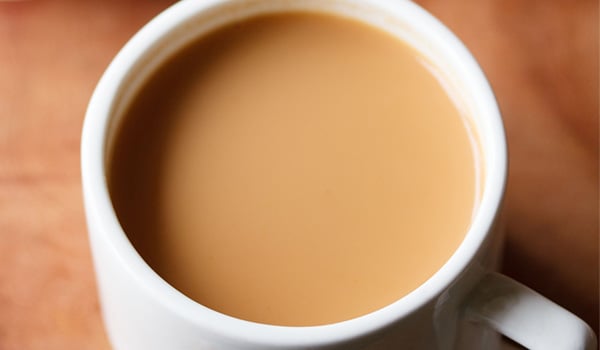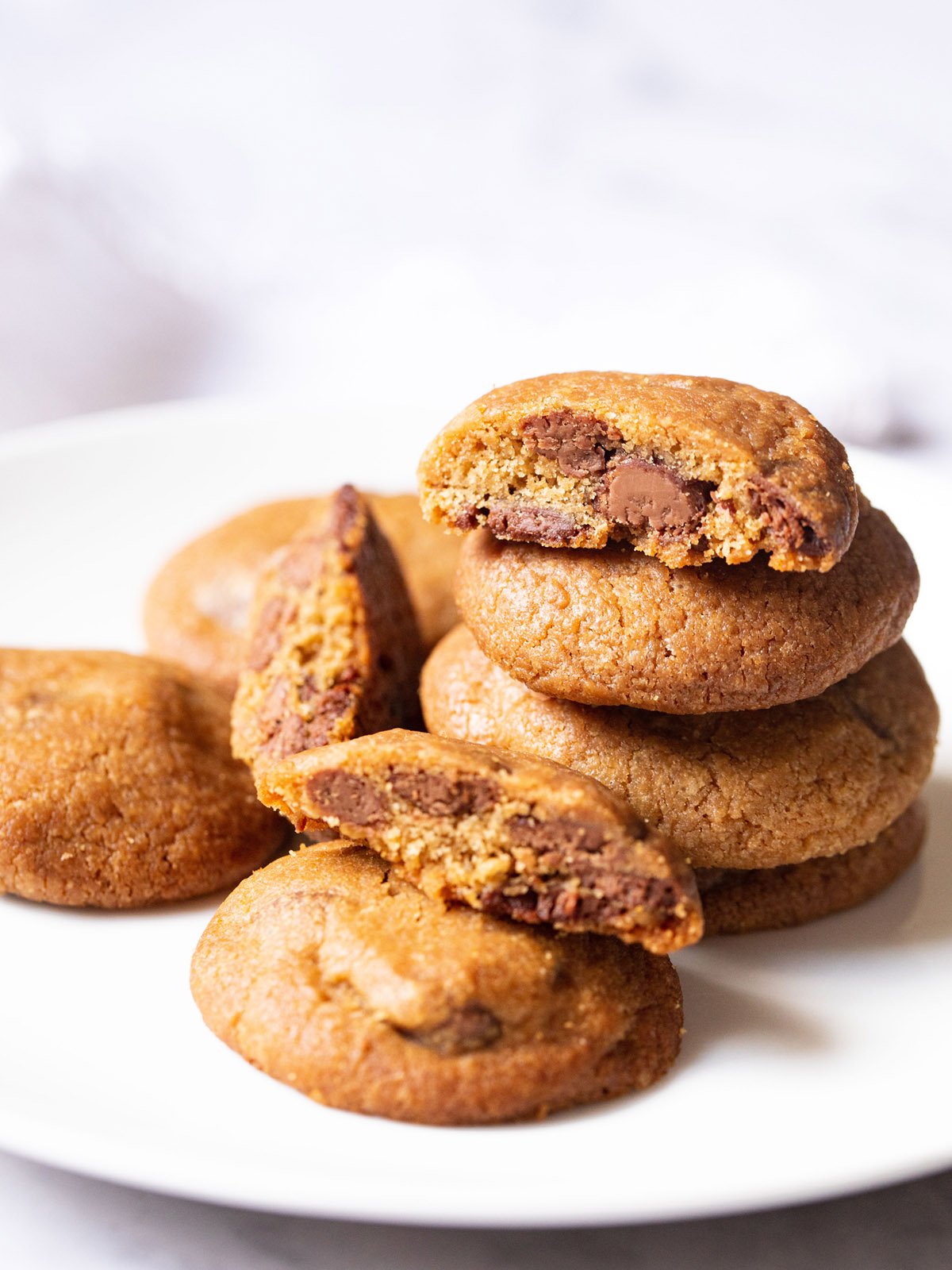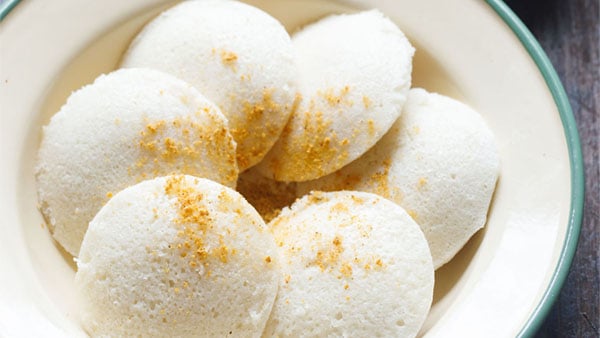Masala Chai, also known as Masala Tea, is a beloved Indian beverage crafted by brewing black tea with a medley of aromatic spices such as cardamom, cloves, and cinnamon, combined with milk, sugar, and water. This spiced tea is not only comforting and bold but also bursting with flavor, making it an ideal choice for breakfast or an evening tea break. Prepared in just 10 minutes, this homemade version is sure to warm your heart and refresh your spirit.
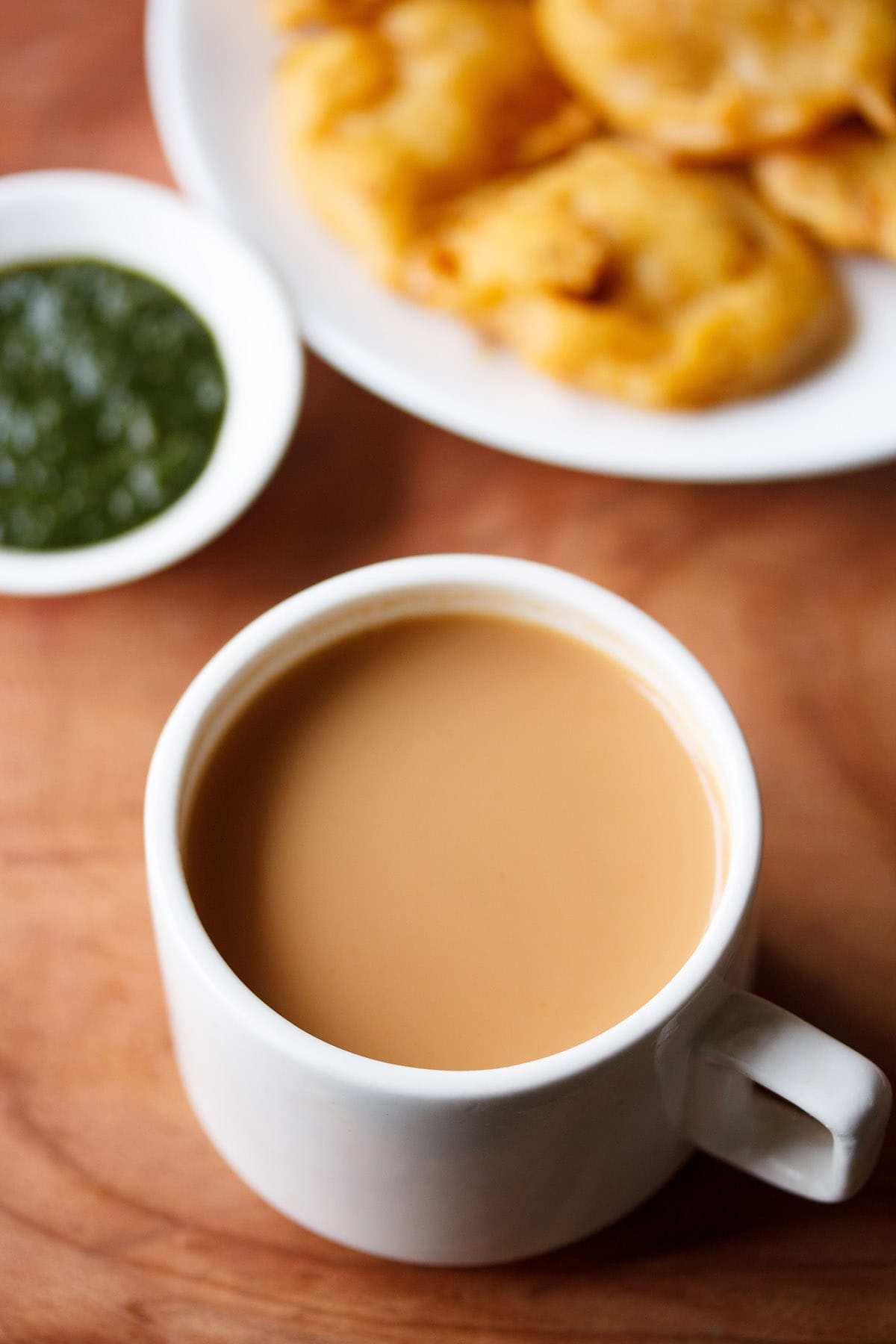
About Masala Chai Recipe
The term masala translates to “spices” and chai means “tea.” Thus, Masala Chai is essentially tea infused with a blend of spices, sugar, and milk.
This delightful beverage is made using staple ingredients found in nearly every Indian kitchen: black tea powder, water, milk, sugar, and a variety of aromatic spices and herbs.
If there’s one drink that truly unites India, it is Masala Chai. While chai alone is a daily ritual for many, the spiced version holds a special significance in our hearts.
Masala Chai is much more than just tea; it is a deeply comforting drink that embodies the flavors of home. The choice of spices can be tailored to suit individual family preferences, with many households boasting their own unique recipes.
Indians not only cherish tea but also have a habit of adding various herbs and spices to their daily brews, with variations differing from region to region and kitchen to kitchen.
It’s safe to say that most Indians cannot imagine starting their day without a cup of Masala Chai. The same goes for the evening, when chai becomes a cherished part of our daily routine.
As previously mentioned, Masala Chai is made by brewing tea leaves in water with spices and sugar, followed by the addition of milk.
For health-conscious drinkers, lighter versions without milk are available, offering a clear spiced tea that remains rich in flavor.
Depending on your taste and health preferences, the quantity and type of spices can always be adjusted or even omitted.
Spices & Herbs To Flavor Your Chai
- Cinnamon – Known for its fragrant, warm, woody aroma, cinnamon also boasts antibacterial, antifungal, and antioxidant properties.
- Cloves – Impart a mild, sweet-pungent taste to the tea and are rich in antioxidants, offering antimicrobial benefits.
- Green Cardamom – Infuses a lovely sweet fragrance. You can crush the whole green pods or use ground cardamom powder. Cardamom aids digestion and acts as a natural mouth and breath freshener.
- Ginger – A warming and pungent herb that can be added crushed or grated. Ginger helps relieve morning sickness and nausea, and is known for its antimicrobial and anti-inflammatory properties, as well as its benefits for digestion.
- More Herbs – Consider adding herbs like mint leaves, lemongrass, and spices such as nutmeg, fennel seeds, black pepper, and long pepper to your chai. Ayurvedic herbs like Ashwagandha and Mulethi (licorice root) are also excellent additions.
A detailed post on Herbal Tea featuring more information about various spices and herbs commonly used in Indian teas is also available.
Which Tea To Use
In Indian households, the type of tea used for everyday chai is black tea that comes in granular form. The two main types are Tea Dust and CTC, both referred to as tea powder.
CTC stands for Crush, Tear, and Curl. The tea leaves are processed using cylindrical rollers, resulting in a granular texture or pellet form, known as CTC or Mamri tea.
A stronger variety, such as Assam tea, is the preferred choice for making this drink, although some people opt for the lighter and milder Darjeeling tea.
Premade mixes of both Assam and Darjeeling tea or Assam and Nilgiri are also available for convenience.
We typically prepare our chai using Assam tea powder, as its robust and bold flavor complements the intense spices beautifully.
You can also use tea leaves or tea bags. If using tea leaves, steep them in the water for 2 to 4 minutes to achieve your desired flavor.
In India, tea powder can be easily found in grocery stores. For those living outside India, Assam tea powder, tea leaves, or tea bags can be purchased from Indian grocery stores or online. Opt for organic tea powder or leaves if possible.
This post includes a recipe demonstrating how to make Masala Chai without using premade Masala Tea Powder.
How to make masala chai with premade spice mix
When using Masala Tea Powder, simply add it to the water and boil for a few minutes. Then brew the tea, add sugar, and milk.
For 4 cups of chai, you can add about ½ to 1 teaspoon or adjust according to your taste preferences.
If you enjoy spiced teas, you might also like this classic robust Ginger Tea and delicately flavored Mint Tea.
How to make Masala Chai
Here is my everyday version of Masala Chai recipe; feel free to adapt it to your taste!
This Masala Chai recipe serves 2 to 3 and can easily be halved, doubled, or tripled by adjusting the ingredient amounts.
Serve Masala tea steaming hot on its own or with Indian snacks such as Onion Pakoda, Samosa, Aloo Tikki, sandwiches, rusk, khari biscuit, nankhatai, or cookies.
Crush The Spices
1. Add 1 inch of cinnamon, 2 to 3 green cardamoms, 2 cloves, and 1-inch peeled ginger to a mortar and pestle. Use true cinnamon, not cassia cinnamon.
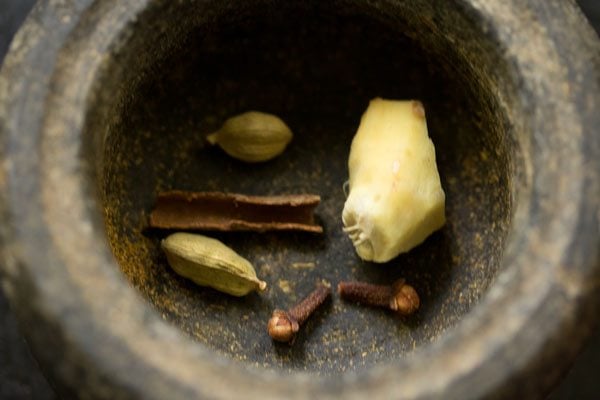
2. Crush coarsely with the pestle and set aside, ensuring that the ginger is well flattened and crushed.
Alternatively, you can grate the ginger and add the spices whole or crushed.
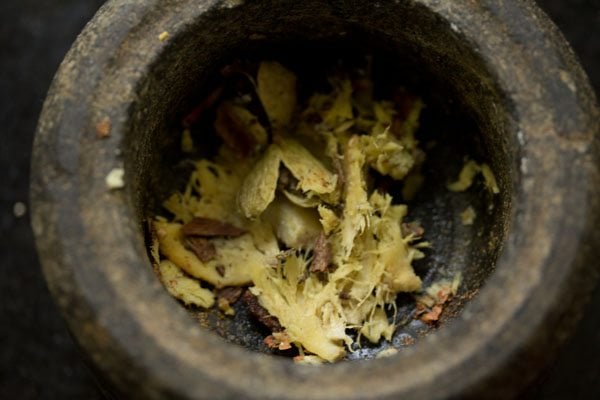
Simmer Spices
3. In a saucepan or small pan with a handle, heat 2 cups of water (500 ml).
Allow the water to come to a boil, then add the crushed spices. If desired, add a generous pinch of nutmeg powder to the spices.
You can also add mint leaves or lemongrass at this stage.
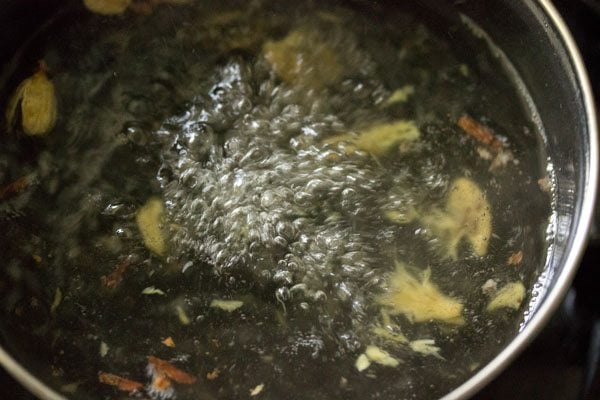
4. Boil for 2 to 3 minutes, then add sugar to taste. I usually add 4 teaspoons of raw sugar, but you can adjust according to your preference.
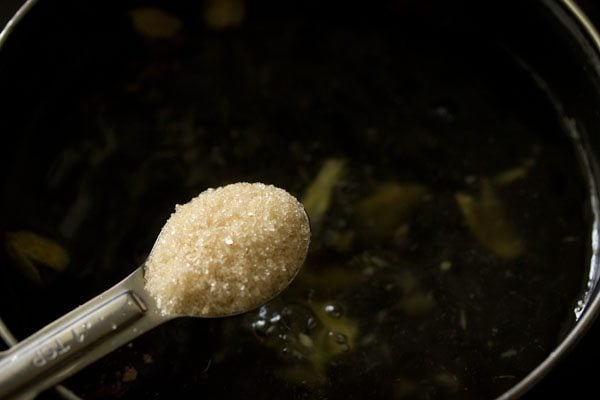
Brew Black Tea
5. Now add 2 teaspoons of Assam tea powder or tea dust. Boil for 1 minute. The boiling time depends on how strong you want your tea.
If you prefer a deeper and stronger brew, simmer for a few more minutes, but be aware that this can impart some bitterness.
Note: If using tea leaves, instead of boiling, steep the tea. Boil the water with spices, then switch off the heat. Add the tea leaves, stir, and cover with a lid.
Steep the tea for 2 to 4 minutes, depending on your preferred strength and concentration. Then add hot milk to the steeped tea, mix, strain, and serve.
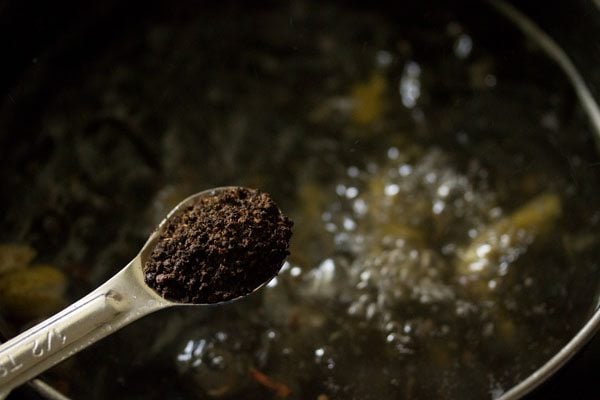
Make Masala Chai
6. Add ¼ cup of milk (at room temperature or cold). You may add more milk if desired.
For a vegan chai, consider using soy, almond, or cashew milk. If using soy milk, add it to the tea mixture and simmer for 2 to 3 minutes.
If using almond, cashew, or oat milk, heat it separately in another small saucepan before adding it to the tea. Avoid boiling these types of milk to prevent a grainy texture.

7. After adding the milk, boil for 2 to 3 minutes. If using chilled milk, boil for 2 to 3 minutes. If using hot milk, simply add it and switch off the heat.
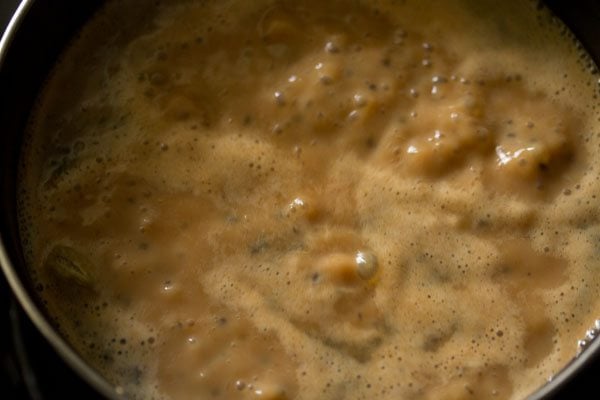
8. Pour the masala tea through a tea strainer directly into a cup.
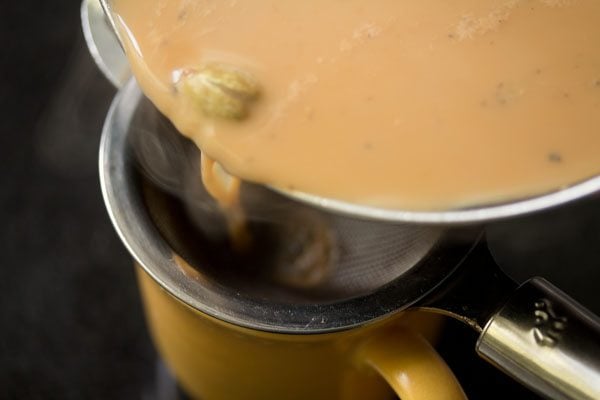
9. Enjoy Masala Chai on its own or serve it steaming hot with your favorite Indian snacks like potato pakora, cutlet, samosa, aloo tikki, onion pakoda, or bread pakora.
This robust, spiced chai can also be enjoyed alongside your favorite cookies or biscuits, or paired with light tea sandwiches for a comforting snack.
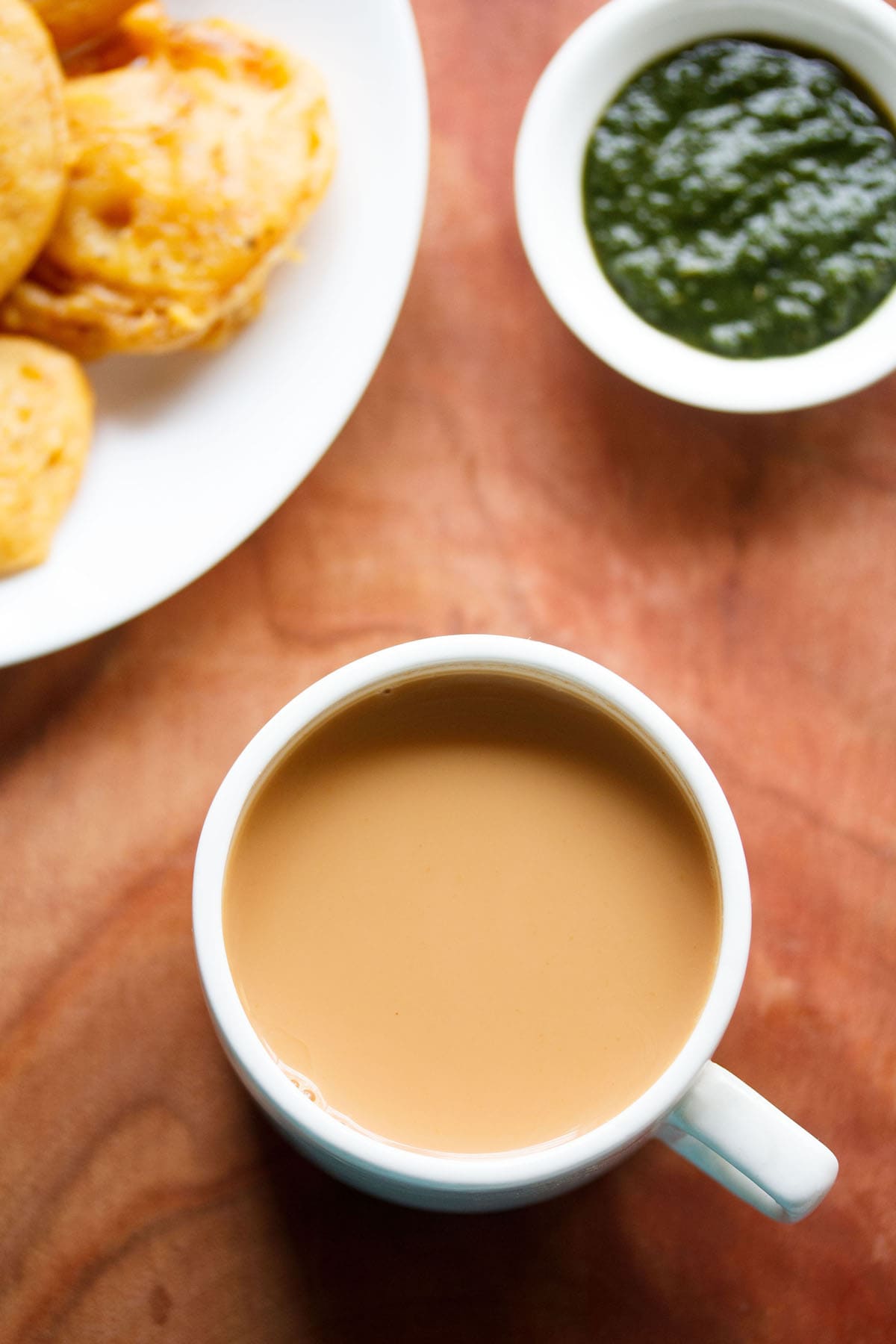
Expert Tips
- Milk: The amount of milk added varies from person to person. Feel free to add milk according to your preference.
- Tea brand: The brand of tea can significantly affect the overall flavor. I always use Assam tea, as it is stronger than Darjeeling tea. However, some people prefer a mix of Assam and Darjeeling tea or exclusively Darjeeling tea. I use organic Assam tea, which is granulated rather than in leaf form.
- Spices: Adjust the quantity of spices as needed. I recommend reducing the spice quantity during summer, as spices can increase body heat and sweating. Conversely, increasing the spice quantity can help keep the body warm in winter or when you have a cold.
- Making tea: The classic method of making tea involves steeping the tea leaves in hot water. The Indian method typically involves boiling the tea leaves for a few minutes. I usually add milk afterward, although some families boil water, milk, and tea leaves together.
- Strong tea: This recipe yields a strong tea due to the robust flavor of Assam tea combined with the spices. Adjust the amount of ginger to suit your taste.
FAQs
It has the flavor of black tea combined with milk, sugar, and the spices or herbs used. The overall taste is determined by the type and amount of spices added, resulting in a fragrant, spiced, astringent, and strong flavor.
While this chai is traditionally brewed with milk, some people enjoy it without. If you choose to skip the milk, I recommend using Darjeeling tea leaves for a different taste.
To create an instant premix, combine ground chai masala powder with milk powder, powdered sugar, and tea powder. Some experimentation will be necessary to achieve the desired flavor profile.
Both options work. I usually crush the pods and include both the seeds and the green husks, as the husks also contribute significant flavor.
More Tea Recipes To Try!

